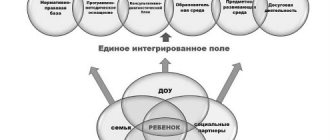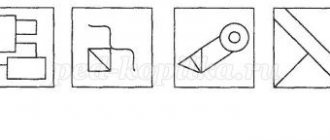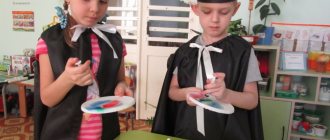Content:
- Features of educational games for children according to the Nikitins’ method
- Which game according to the Nikitins’ method should be offered to children first?
- Rules of Nikitin's games
- Examples of games using the Nikitins’ method Game “Fold the pattern”
- Game "Frames and inserts Montessori"
- Game "Monkeys"
Among the variety of pedagogical developments, developmental methods, children's manuals, educational games, the Nikitins' method for children deserves special attention. Not only because it has long-standing, even Soviet roots, has been successfully tested on the children and grandchildren of famous spouses - teachers, and spread by their followers. The Nikitins’ early development method is simple, accessible and used by teachers not only in Russia, but also in many countries around the world.
The seven children of Lena and Boris Nikitin achieved significant success in development and education, being several years ahead of their peers. An interesting technique, intellectual games for children today not only have not lost their relevance, they have become widespread among modern manufacturers of goods for children, they are produced in different versions, modernized, and used in preschool institutions and development centers.
Boris Pavlovich Nikitin (1916 - 1999) called his pedagogical developments “games for the mind”, since in game development activities he put in first place the independent search for creative solutions and stimulation of new achievements in a developing environment, and not the child’s application of an algorithm for a known solution to intellectual problems. tasks. In his opinion, children should learn to find a way out of a gaming situation without instructions from a teacher: this will be the development of intellectual abilities. And this statement, embodied in Nikitin’s educational games for preschoolers, corresponds to the tasks of modern pedagogical science.
Games using Nikitin’s method are not only intended for preschoolers. They can be played by the whole family, company, as well as by schoolchildren and students; they are even used as rehabilitation activities in nursing homes.
A little about the creation of the system by Boris and Elena Nikitin
Boris and Lena Nikitin created the method in the process of raising their own children, of whom there were seven born in the family. Since the system began back in 1957, it is difficult to imagine what kind of public censure its authors had to face, who, despite Soviet principles, raised their children according to their own rules.
Much of what the Nikitins were innovators in does not surprise anyone today: natural childbirth, immediate breastfeeding, feeding on demand. The sight of children running in their underwear in the snow provoked a sea of criticism, even despite the facts that spoke in favor of such upbringing: children’s good health, high level of intelligence, development ahead of their peers for several years. But the Soviet Union was known for the fact that any action that went beyond the norms and boundaries was doomed to condemnation by society, no matter how weighty the arguments were for the person committing it. The authors deserve enormous respect for such innovation alone.
The principle on which the entire methodology is based: do not interfere, but help the child develop.
The Nikitin system includes the early development of a child’s abilities at the intellectual and physical levels
Boris Nikitin put forward the theory that any abilities in a child can be pushed to development if done in time. And he considered the most appropriate time to start classes with a baby not even the infant period, but the perinatal period. According to this theory, human abilities that do not receive an impetus for development at the right time inevitably fade away and cannot be developed in the future.
And if these abilities (intellectual and other) are not activated early, then later they will “die out” - as unnecessary...
B. Nikitin
https://nikitiny.ru/intellektualnoe_razvitie
Developing his idea, the author criticized the public educational system.
At school, not a single teacher would think of assigning a problem without first explaining how to solve it. This means that at school the child will encounter almost no tasks that can advance him in the development of his creative abilities, and he has less and less free time, until by the time he reaches high school there is none left at all.(…)
From the standpoint of the new hypothesis, the fact of the mass “production” of lagging behind and second-year students in orphanages, in orphanages and in “week-long” kindergartens is also completely explainable. Here, good supervision of the child and a particularly firm daily routine are of greatest importance, in which the baby does not need to solve new problems (...)
B. Nikitin
https://nikitiny.ru/NUVERS
Yes, this confirms that an education system built in this way does not accustom a person to the main thing - to learn and learn, to ask questions and find answers to them, but has a detrimental effect on abilities and basic development. As a result, there is not only creative degradation, but also personal degradation.
Factors contributing to early development (according to the system)
The Nikitins believed that natural development is the best option for a child, but in most modern families it is artificially inhibited. In such cases, it is not the needs of the baby that are taken as the basis, but the stereotypical thinking of adults. Parents believe that they know when the baby is supposed to master this or that skill, and they forbid him to perform some actions under the pretext of “it’s too early,” while, on the contrary, they impose others because they are sure that “it’s already time.”
It is still common to encounter parents, and more often grandparents, who panic if a four-month-old baby tries to assume an upright position. According to the norms, a child should sit independently at the age of six months. The Nikitins did not follow this approach, giving children the opportunity to develop ahead of established standards.
The authors of the system identified the following main factors contributing to early development.
- The child is given great freedom of action. There is no compulsion to study as such. Children study and practice as much as they want.
- The physical development of a child is no less important than his education. It is important to have a sports corner, hardening, and no restrictions on playing sports.
- The indispensable participation of adults in children's activities: games, competitions, creative processes. A child needs to feel his parents’ concern for his successes, but at the same time he should not feel pressure and specific requirements for his abilities.

Physical development is as important for a child as intellectual development
Pros and cons of the technique
Despite all the controversial issues that may arise in the process of studying the Nikitin system, practice shows that there are undoubted advantages of it. Even methods such as hardening, which still seems radical to many, give consistent results.
- Children raised according to the Nikitins' method are distinguished by good health and endurance.
- Development occurs much earlier, and the mental abilities of children are not limited by a given program, as can be observed in children raised according to standard principles. A way of thinking is formed that solves problems, both mathematical and everyday.
- Living conditions, everyday life - everything is arranged and distributed in such a way that it is easy for parents and children to fulfill their responsibilities and no one feels overloaded.
Features of educational games for children according to the Nikitins’ method
The help of an adult, a teacher or a parent, is required only at the very beginning, when it is necessary to offer a game to the child, to involve him, to interest him. There is a small psychological moment here - you need to guess the baby’s mood so that it is interesting and comfortable for him to play in a new developmental environment.
- Each game consists of several problems; the child must find a solution using figures, parts, pictures, etc.
- Tasks can be presented in various forms (drawings, drawings, designs, models, etc.), so they stimulate the knowledge of different ways of transmitting information.
- Game tasks should be introduced with increasing difficulty levels.
- Game tasks have a different range of difficulties, from simple ones for 2-3 year olds to complex ones for an adult player. Therefore, Nikitin’s games are interesting at any age.
- The gradual complication of game tasks stimulates the child’s intellectual development, forcing him to think, move forward, and independently develop in creative search.
- An adult should under no circumstances interfere in the child’s play, should not give hints, allowing him to find a solution to the problem situation on his own.
- The child should not be required to immediately solve a game problem. He must reach everything on his own, even if it takes a day, a week, a month.
- The answer to the game task should be visual, tangible, in the form of a diagram, drawing, model, so that the child himself can be convinced that he is right, in his correct choice of solution.
- Educational games should not be limited to the proposed tasks, they can be supplemented, you can come up with your own, new ones, or you can develop more complex or more creative games yourself.
- Intellectual games help you find out the limits of your capabilities.
Thus, the goal of educational games according to the Nikitins’ method is to develop various intellectual qualities in children: memory, attention, spatial imagination, the ability to perform logical calculations, search for patterns, the ability to classify, and find their mistakes. While playing, the child learns to be smart, inventive, and develops creative thinking.
Advantages and disadvantages
The advantages of the technique include the following.
- This approach allows you to achieve comprehensive physical and intellectual development.
- Helps improve logic, intelligence, spatial thinking, imagination, memory, and the ability to find non-standard paths.
- Teaches kids to be independent, persistent and purposeful from an early age.
- Helps to gain basic knowledge about the most important abstract concepts, which will be useful in the future at school.
It should be noted that the technique is not without its drawbacks.
- Exercises and games are carried out with the interaction of the baby and parents, which, of course, is very useful, but limits the child’s communication with peers.
- The development of a preschooler will not be comprehensive when using only the Nikitins’ methodology, so it should be supplemented with recommendations from other teachers.
- The system is focused on home education, so often children who developed exclusively using this method find themselves unprepared for school life.
- Due to the lack of story-based and role-playing games, the baby does not learn to play; throughout the day he trains his brain, which leads to significant energy expenditure and causes fatigue. Such a child is deprived of many bright moments of childhood.
Let us note that the method has far fewer disadvantages than positive aspects, and they can be easily removed by caring parents who will give their child the opportunity to communicate with peers, play with them the way the child himself wants, and relax.

Which game according to the Nikitins’ method should be offered to children first?
If educators have several educational, intellectual “Nikitin’s games” at their disposal, then it is advisable to first deal with each of them yourself in order to find out the contents and level of complexity. You can try playing it yourself to evaluate the range of tasks and the time required. Taking into account the age, temperament and character of the child or group of pupils, the easiest game tasks should be introduced first, moving towards more complex ones. For example, if children have become accustomed to the game “Fold the Pattern,” then periodically after a few days the games “Monkeys,” “Montessori Frames,” “Dots,” “Attention,” and others should be introduced.
Educators may be interested in the question: is it possible to keep a group of children occupied by offering them several different games at once using the Nikitins’ method? Boris Nikitin himself claims that this is possible if at least two of the three games have already been mastered and the students are interested. At the same time, it is undesirable to set aside a certain time for gaming activities - 5, 10 minutes, create a time frame and stop. As long as the child is interested and is not reprimanded, let him solve logical problems and complete the task.
Didactic game “Pick a pattern”
For the lesson, prepare game material:
- take light A4 cardboard and white plastic drink lids;
- Divide the cardboard sheet into squares of equal size;
- there should be one cap for each sector;
- With a black marker, draw a pattern on each square, similar on the corresponding lid (it should not be repeated on other squares and lids);
- Laminate cardboard with transparent adhesive tape to extend its service life.
The players' task is to find a suitable cap for each square. The activity is exciting, preschoolers play willingly, thereby developing memory, concentration and perseverance.
Rules of Nikitin's games
- The game should be fun. Every child’s success is a great and common achievement.
- The child should be interested in the game, but should not be forced. Moreover, there is no place for offensive remarks here.
- Educational creative games require children's independence and adult non-interference. Let the child think for himself, look for his mistakes himself, climbing the ladder of increasingly complex tasks.
- To assess the difficulty of the game, before engaging the children, you should play it yourself and time it.
- You need to start with easier and simpler tasks, since success at the very beginning is an important condition.
- If a child cannot solve a game problem, it is beyond his strength, then it is worth retreating and taking a break. And after a few days, resume classes with an easier game. And it’s even better if the child chooses the game himself according to his capabilities.
- If there are several children in the family, then everyone needs to prepare a set. In kindergarten, it is advisable to prepare several sets of games.
- The simplest games, which the author of the method recommends teaching first, are “Fold the Pattern” and “Montessori Frames and Inserts.” These games focus on color and shape recognition. At the same time, B.P. Nikitin recommends that adults start keeping a diary of the child’s successes, recording the order in which new games are introduced.
- Children become interested in games from time to time, so when interest in activities disappears, they should forget about the game for several days or a month. When interest arises again at the encouragement of adults, success in the game can be much better.
- Games according to the Nikitins’ method should be protected, not left with toys, and put away in a visible but inaccessible place for children.
- When practicing according to the Nikitins’ method with the youngest children from 1.5 to 3 years old, it is advisable to give the game the form of a fairy tale, come up with a plot, and give the figures, patterns and models names. The imagination and emotions of the teacher play a big role in the process of enthralling children.
- Play activities should stimulate the child’s development of individual character traits. Students should be praised more for their achievements and encouraged in case of failures.
- Gaming activities should take place in a comfortable and relaxed environment. If fidgety children want to jump for joy or somersault, they should not hold back.
- If at the game stage all the patterns have already been folded, all the models have been assembled, then you can come up with new tasks yourself. It will be great if the children themselves begin to write down and sketch new examples of achievements in the diary.
- Children of older preschool age can have competitions in solving speed problems. And pupils aged 6–7 years are quite capable of serious competitions with adults. Winning an adult is a great joy for a child.
Goal and tasks
As the Nikitins believed, the key goal of raising a child is the development of a creative personality, and it is on this that the basic principles of the methodology are based. The purpose of the system they developed can be formulated in a similar way.
The objectives of the methodology are:
- harmonious intellectual and physical development of the child from an early age;
- the formation of his independence due to the non-interference of parents in the process of solving a specific problem;
- doing certain exercises helps the child understand colors and basic geometric shapes;
- didactic games are aimed at developing the child’s logic, thinking, and memory in an unobtrusive and easy way.
Many developmental tasks of the Nikitin family appeared during their direct communication with children, with the participation of the latter, and therefore are accessible to children, useful and interesting to them.
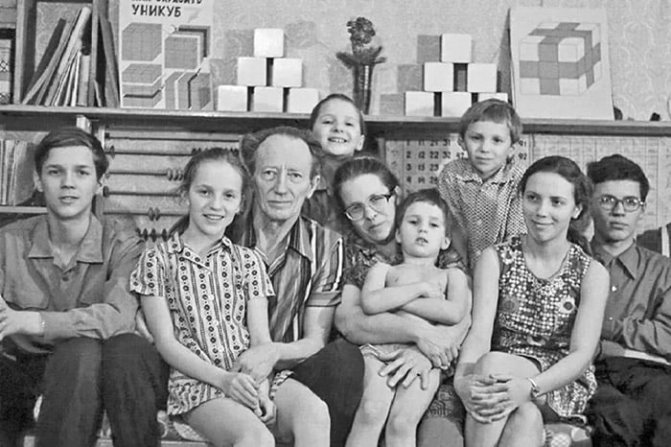
Examples of games using the Nikitins' method
Game "Fold the pattern"
This game comes with 16 cubes of the same size. The standard is 3 x 3 x 3 cm. In this case, the faces of each cube are painted in 4 colors, and two of the 6 faces (opposite) are painted in different colors diagonally. Thus, only 4 colors are involved.
You can make different patterns from the cubes, choosing colors in any order.
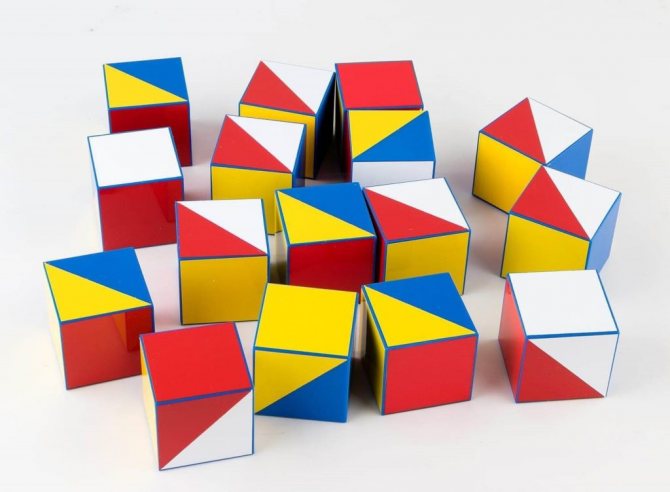
By rearranging the cubes, you can create a large number of options for paintings, patterns, schemes, coming up with names for them.
In this game there are three standard tasks: to create a similar pattern according to a given (drawn) pattern, then to create (sketch) a pattern using the pattern folded with cubes, and the third is to come up with new patterns from 9 or 16 cubes.
Schemes - tasks on ready-made cards for the game can be selected in full size so that they can be covered with cubes.
With toddlers, you can play “Fold the Pattern” by first using 4 cubes, making one-color pictures, then gradually introducing the next cubes, making the pattern more complex. You can offer to create a simple pattern yourself and come up with a name for it.
Pupils of senior preschool age can have exciting competitions in the game “Fold the Pattern”. If you divide them into several teams and distribute a set of cubes, then the children will be happy to wait for a new task from the leader and put together patterns according to the diagram. And the teacher can summarize the results in a table, which team added faster, which was more correct, and which came up with more new patterns.
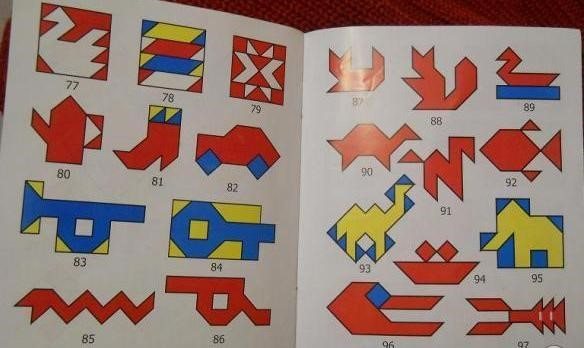
B.P. Nikitin invites adults to pay attention to one very important point: just as we take out a box of cubes, carefully lay them out or noisily dump them all at once, so children will either carefully collect the cubes after playing or scatter them around the room. Handling objects is stored in children's memory; children tend to imitate adults in everything.
By playing “Fold the Pattern,” kids learn to think independently, control and evaluate themselves, and see their own mistakes.
Game "Frames and inserts Montessori"
The basis of this game is mainly the pedagogical developments of the Italian teacher M. Montessori. B.P. Nikitin only slightly changed the completeness and conditions. Game tasks introduce preschoolers to geometric shapes, prepare children's hands for writing, and develop logical thinking.
The game set consists of square plates - frames measuring 10 x 10 cm and about 2 mm thick. Each frame has a hole in the center into which an insert of the corresponding geometric shape and suitable size is inserted, but differing in color.
Here is a list of figures:
- Circle
- Square
- Equilateral triangle
- Ellipse
- Rectangle
- Rhombus
- Trapezoid
- A quadrilateral with irregular sides and one right angle
- Parallelogram
- Isosceles triangle
- Hexagon
- Five pointed star
- Right isosceles triangle
- Pentagon
- Irregular hexagon
- Scalene triangle.
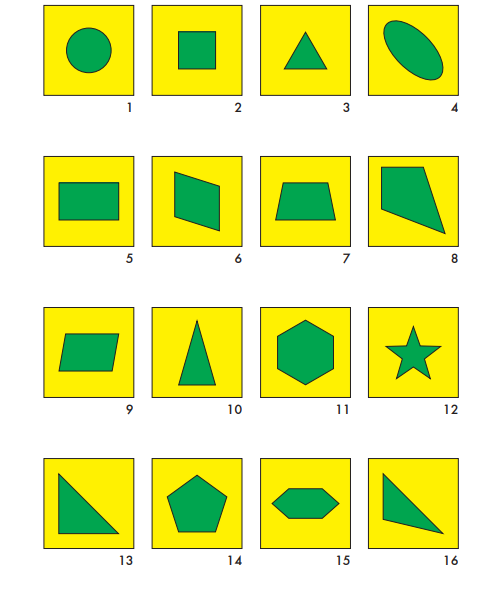
During the game, the frame with the corresponding insert must be named according to the shape of the figure (rhombus, star, circle, etc.).
The number of frames and game tasks for each game are prepared in accordance with the age and capabilities of the children.
Task options:
- Find inserts and insert into frames
- Trace the outlines of the figures (along the frame, along the insert)
- Color the figures with colored pencils
- Outline the figures with a double outline
- Create an ornament from figurines
- Guess the figure by touch
- Insert the inserts into the frames with the eyes closed
- Arrange frames and figures - inserts according to properties.
Game "Monkeys"
This wonderful game is based on children's ability to imitate. Children often copy the behavior of adults, thereby adopting habits, ways of handling objects, and emotions. Young preschoolers have very developed qualities such as attention, observation of adults, and the ability to imitate. These qualities change with age. The game "Monkeys" allows you to evaluate how attentive a child is, or whether this quality is fading.
The game is designed for children from 2 to 3 years old. Children need to be seated at a table so that they can hide their hands under it. The presenter begins the game with a short introduction - a fairy tale: a little monkey was sitting in the room, she was bored, she saw a boy, first hid from him, and then began to repeat all the movements after him and she really liked it. Now all the children - the monkeys - repeat the movements after the boy - the leader (teacher). For the kids, you need to prepare identical wooden blocks or bricks and distribute 2 pieces to each. You can borrow them from any gaming kit. The presenter raises his hands from behind the table and puts his bricks in a certain composition, places them on the edges, in a tower, in the letter “T”, in any way. Children - monkeys must repeat the composition exactly - exactly - from their blocks. In this case, the leader must perform the movements demonstratively slowly, sometimes a little faster, noisily or quietly, but very emotionally, verbally encouraging the monkeys. Having finished the composition, they begin the next one. Having hidden their hands under the table, then taking out the figures, the monkeys again repeat after the leader and build a new composition.
As a result, children develop attention and learn to repeat the actions of the leader. You can complicate the game by introducing new figures, including different colors.
The list of Nikitin games and puzzles is quite large. All of them are aimed at developing logical thinking, memory, attention, and creative imagination. Children's talents need to be developed from an early age, creating a creative environment and engaging the child with intellectual games. Lena and Boris Nikitin think so. And all teachers agree with them on this.
If you found the information on the site useful, please share it on social networks:
Principles of the method in raising children under one year old
The goal of the technique, designed for children under one year of age, is to create the most necessary conditions for the child. This age is more characterized by physiological development, which is the basis for further growth of intelligence. The beginning of the implementation of the Nikitin methods is not even infancy, not childbirth, but all the time from the moment of conception.
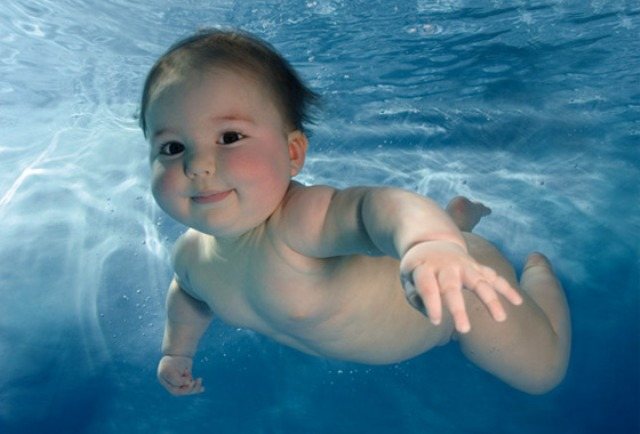
The physical development of children under one year of age is the basis for their further intellectual growth
Fundamental nuances of development up to one year
- Family atmosphere. Every child should be desired and raised in love and harmony between parents.
- Pregnancy. During this period, certain conditions must be observed: abstinence from nicotine, alcohol and medications, an active lifestyle for the expectant mother, and mandatory communication with the fetus.
- Childbirth. They should take place without the use of medications, preferably at home. Attachment to the breast occurs immediately after birth (even before the placenta comes out).
- Feeding the baby. Until the first tooth erupts, the baby should receive only breast milk and clean water. Feeding occurs on demand. From the very beginning of introducing complementary foods, there is no need to heat food to a certain temperature.
- Contact with mother. From birth to one and a half years, the child should have contact with his mother as often as possible, including the night period (sleeping together).
- Congenital reflexes. In no case should the development of motor reflexes (crawling, grasping, swimming, attempts to sit independently, walk) be prevented, no matter how early they appear.
- An environment conducive to development. Sports equipment is a natural household item. Availability of construction sets, manipulative games, office supplies (paints, pencils, plasticine, etc.) in constant access.
- Freedom in knowledge. Do not limit the child’s movement or crawling. Playpen - maximum for an hour a day.
- Hardening. From birth, after bathing in warm water, it is necessary to pour cool water over either the entire body or just the baby’s legs.
- Sleeping in the air. In any weather, in any frost, daytime sleep should take place in the fresh air.
- Lack of sterility. Cleaning the premises is very basic. No special sterility.
- Hygiene. In addition to standard daily bathing, the Nikitins trained children to use the toilet from birth, sitting them over a basin even at night.
- Lightweight clothing. It should not hinder movements. At home, where the temperature is about +20 degrees, children walk barefoot and in underwear. Infants do not wear hats indoors; their bodies are exposed to air as much as possible. At the same time, open windows are normal.
- Safety precautions. The best way to let a child understand that an object is dangerous is to allow him to come into contact with it. You will not be able to control your baby 24 hours a day and protect him from, for example, spilling boiling water from a kettle on himself. But if the baby touches something hot and gets a slight pain, he will definitely remember the danger.
As you can see, Nikitin’s methods of raising his children under one year old seem cruel and unsafe. Many modern parents cannot imagine that their child can be outside at a temperature of +10 without a warm hat and full winter gear. Of course, you can panic at the sight of a baby licking a rattle that you washed with soap an hour ago, but you can look at the facts. The facts are that in practice, the Nikitin children always had good health and were ahead of their peers in development.
How to choose Nikitin cubes
Like any other toy, Nikitin’s educational cubes should be chosen based on the child’s wishes. If he liked the wooden blocks, there is no need to force multi-colored cubes or squares on him. When choosing Nikitin cubes, you should take into account the child’s age and the complexity of the game, as well as the child’s psychological and physiological characteristics.
You need to start simple. Even if the task seems elementary to you, let your child set an example: let him feel the taste of victory, and only then move on to a more complex level using task albums.
The game is easy to find for free. You can buy Nikitin cubes in toy stores or order them in online stores. Another option is to buy it on the official website of the Nikitin family with delivery from Moscow or St. Petersburg by mail. The price of Nikitin cubes varies from 350 rubles to 3500 rubles: the exact cost depends on the manufacturer, materials, and size of the set. On the official website it will be more expensive, but of better quality.
